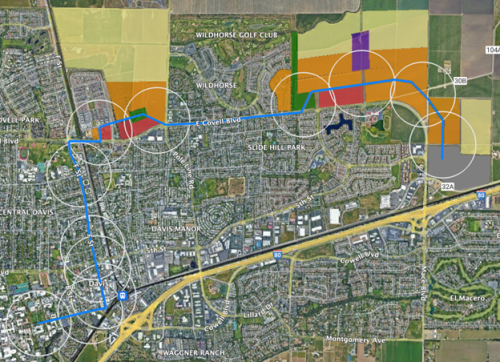The following comments were submitted to the City of Davis by the Sierra Club Yolano Group on December 8. Transmitted via email to <SMetzker@cityofdavis.org>
Biological Resources
1. The Biological Resources should be studied in detail as outlined in the 5 December 2023 letter from Madrone Ecological Consulting, “Subject: Summary of Biological Resources Surveys Planned for the Village Farms Project, Yolo County, California.” but with the following suggestions:
- In the Aquatic Resources Delineation study, we recommend the timing of the determination of the extent of wetlands be expanded to include any times in which the area is water-inundated rather than at specifically identified times because inundation can occur during variable periods.
- We recommend the then current leasehold farmer not perform any cultural activities resulting in soil disturbances, including planting of cover crops, until the all wetland studies are completed.
- In the analysis for rare plants, we recommend all historical records be consulted.
- All surveys performed for determination of Biological Resources should be performed by specialists approved or certified to perform such studies under CEQA guidelines and performed in accordance with CDFW protocols.
- Environmental evaluation should also be performed considering the Yolo Regional Resource Conservation Investment Strategy/Land Conservation Plan (RCIS/LCP) in addition to the Yolo Habitat Conservation Plan & Natural Community Conservation Plan (HCP/NCCP).
Traffic
2. The Traffic impact analysis should be studied for cumulative impacts of all the four proposed properties on Covell and the Mace curve including Village Farms, Palomino Place, Eastside (formerly referred to as Shriners), and On the Curve, as would be done in an East Covell – Mace Curve Specific Plan to assess cumulative impacts.
3. Below is a diagram which illustrates the relationship between the developments by indicating the 1⁄4 mile walking distance of each proposed project. The proposed transportation mitigation should be developed in light of these findings to minimize walking distance to public transit
Alternatives
4. We recommend that the DEIR analyze a co-op model (perhaps similar to Dos Piños or Muir Woods) as a supplement to the proposed starter-home program, and explore the possible environmental benefits that such a model could produce and analyze the impact of Community Gardens on GHG emissions and VMT.
Hazardous Materials
5. We recommend that an additional sample from each of the seven existing monitoring wells that are still accessible on the Village Farms site and the city-owned property to the north of the site be taken and analyzed for toxic contaminants including PFAS (“forever chemicals”) and determine the direction of the aquifer flow. Existing ag wells on the site planned for irrigation use in the project should be tested for the presence of toxics and contaminants including PFAS (“forever chemicals”).
The Scope of Work for Raney Environmental indicates the following, “Raney anticipates the provided Phase I ESA will include soil sampling across the entire project site to test for persistent pesticides and other potential contaminants.” We recommend including analysis for PFAS. (“forever chemicals”) in these soil surveys
Hydrology
6. We recommed the potential impact of peak flows and volumetric capacity on the project and downstream system be studied using a 200-year flood event in the Drainage report in addition to using a 100-year flood event
Cultural Resources –
7. We recommend that the Yoche Dehe Wintun Tribe and other tribal groups be consulted with more than a certified letter to notice them of the upcoming DEIR and consultations opportunities




Leave a comment